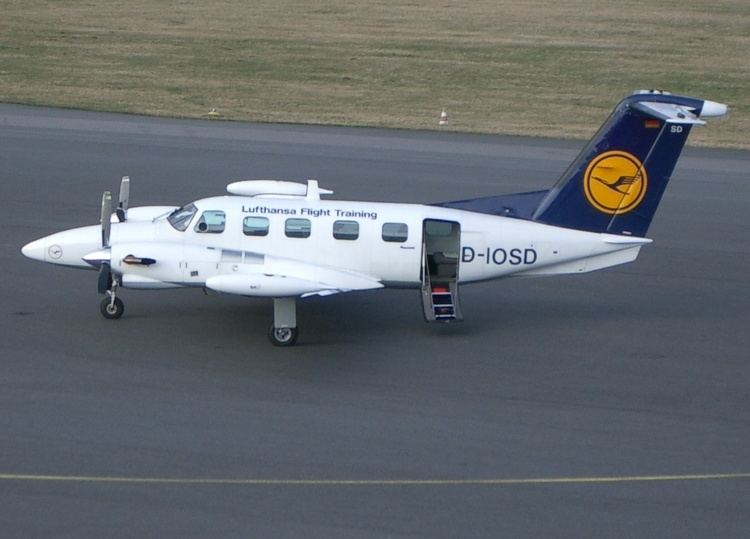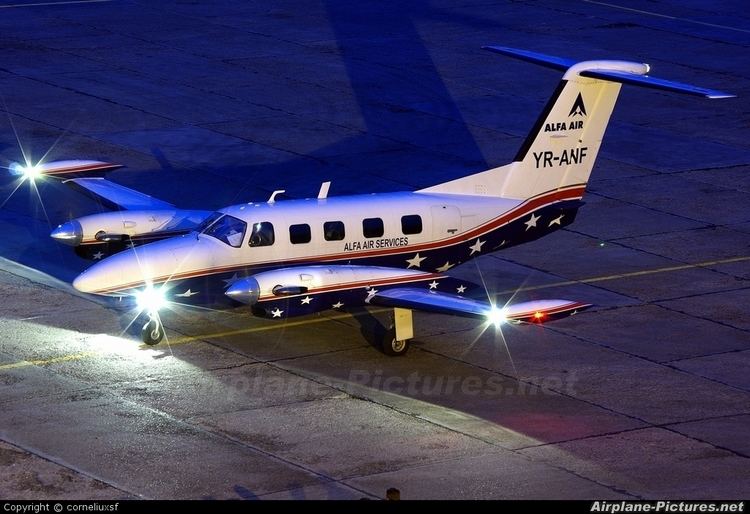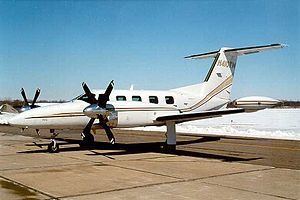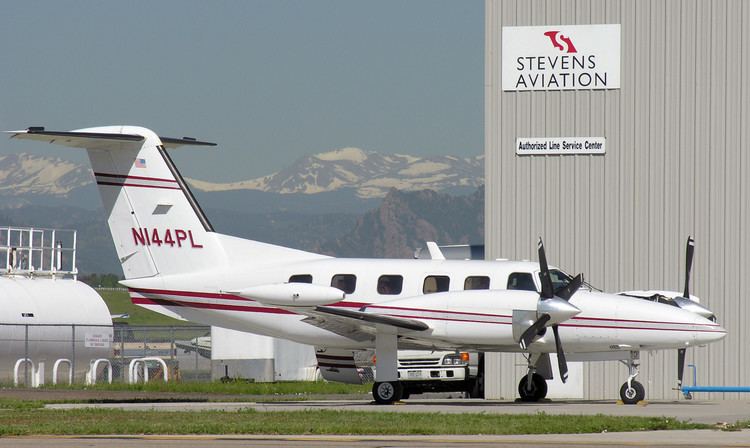Top speed 582 km/h Length 13 m | Wingspan 15 m | |
 | ||
The Piper PA-42 Cheyenne is a turboprop aircraft built by Piper Aircraft. The PA-42 Cheyenne is a larger development of the earlier PA-31T Cheyennes I and II (which are, in turn, turboprop developments of the PA-31 Navajo).
Contents

History

The Piper Cheyenne prototype first flew in 1969. Designated the PA-31T-620, it was essentially a turboprop evolution of the Piper PA-31 Navajo, powered by two Pratt & Whitney Canada PT6A-28 turboprops rated at 620 hp (460 kW) each. Certification was granted on 3 May 1972. The original Cheyenne, produced from 1974 to 1977, did not carry a Roman numeral suffix designation. Because of difficulties complying with certification standards for longitudinal stability, the Cheyenne and later Cheyenne II are equipped with a Stability Augmentation System (SAS), consisting of a stick-pusher system (actuated by an angle-of-attack sensor) designed to provide the pilot with the appropriate stick force gradient – and to keep the airplane at its trim airspeed when flying near aft center of gravity loadings, high power settings, low airspeeds and high angles of attack. Without the SAS, the aircraft demonstrated neutral static stability in its flight regime. Later in 1978, it was redesignated as the Cheyenne II (PA-31T-2-620), due to the production of the PA-31T-1-500.

In 1978, the Cheyenne I (PA-31T-1-500) was introduced. Powered by two 500 shp (370 kW) Pratt and Whitney PT6A-11 engines, the Cheyenne I was marketed as a low-cost step-up turboprop for Piper loyalists. Due to its reduced power, this airplane does not require an SAS. The Cheyenne IIXL (PA-31T-2-620XL) is a stretched (by two feet) version of the Cheyenne II. Certified in February 1981 and built until 1984, it does not use SAS.

The Cheyenne IA (PA-31T-1A-500), certified May 1983 and produced until 1985, brought together several design improvements to the basic Cheyenne I. A redesigned cowling allowed more air to flow into the engine; situating the propeller closer to the engine air scoop allowed greater recovery of high-velocity ram-air. New, streamlined exhaust stubs yielded more jet thrust than previous models and kept nacelle soot accumulation to a minimum. Together, these changes allowed higher inter-turbine temperature (ITT) limits. Other improvements to the standard airplane airframe included an auto-ignition system, automatic starter disengage for simplified starting procedures and a larger windshield.

The PA-42-720 Cheyenne III was announced in September 1977. The first production Cheyenne III flew for the first time on May 18, 1979 and FAA certification was granted in early 1980. Compared with the Cheyenne II, the PA-42-720 was about 1 m (3 ft) longer, was powered by 537 kW (720-shp) PT6A-41 turboshafts and introduced a T-tail, the most obvious external difference between the PA-31T and PA-42, as well as the most significant change to the series. Deliveries of production Cheyenne IIIs began on June 30, 1980. The standard Cheyenne III has a full complement of deicing equipment, Q-tip propellers, more powerful 250-ampere-hour starter-generators and a 6.3 psi pressurization system backed up by an emergency system operated by the right engine's bleed air.

Several key upgrades found available for the Cheyenne IA also became standard for the III. These included the SAS, redesigned exhaust stubs, which, according to Piper, allowed an extra 6 knots (11 km/h) IAS; and a redesigned engine intake air scoop, which allowed for a larger volume of air to enter the engine. In addition, an external air scoop for oil cooling was available instead of using engine intake air.
The IIIA superseded the Cheyenne III after 88 of the latter aircraft had been delivered with FAA certification in March 1983. The IIIA is similar in appearance to the III but has PT6A-61 engines and 300 ampere starter-generators. The PT6A-61 engine delivers the same 720 horsepower (540 kW) but, with an additional axial compressor, carries that horsepower to a higher altitude. The IIIA also features an improved air conditioning system, speed stacks, increased passenger headroom, and more reliable fuel control units. The IIIA's ordered by Lufthansa feature flight decks configured to resemble that airline's Airbus A310. Alitalia also uses the IIIA for training purposes.
The higher-powered and significantly faster PA-42-1000 is basically a PA-42-720 with far more powerful 1650 shp (de-rate to 1000 shp) Garrett TPE331-14 turboprops (later TPE331-14-801) driving four-blade, 109-inch-diameter (2,800 mm), composite-construction Dowty Rotol propellers. The Cheyenne 400LS was originally designated the IV, but was renamed to reflect its top speed and its status as Piper's luxury flagship, as measured in miles-per-hour. It is the hotrod of the line and was, in fact, the fastest production turboprop in the world at the time of its introduction. In Piper's catalog from 1984to 1993 (although the 41st and last 400LS built, N313PC, was built in 1989), it was designed to compete with smaller fanjets, having performance comparable to jets like the Cessna Citation with a roomier cabin and significantly lower fuel consumption, especially at lower altitudes.
Cheyenne PA 42 1000 max S/L speed (cruise) 335 knots, four-blade prop, or with new five-blade German MT prop nearer to 340 knots.
Variants
Specifications (PA-42-720 Cheyenne III)
Data from Jane's All The World's Aircraft 1988-89
General characteristics
Performance
Operators
The aircraft is operated by private individuals, companies and executive charter operators. A number of companies also use the aircraft as part of fractional ownership programs.
